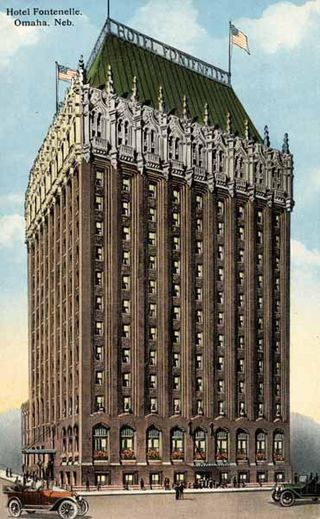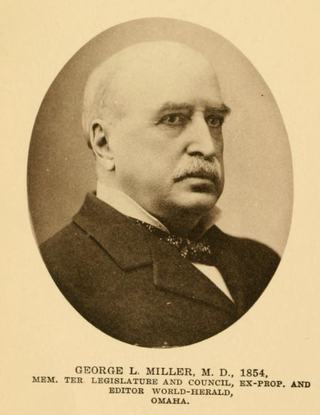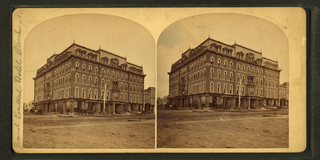
The University of Nebraska Omaha is a public research university the central United States, located in Omaha, Nebraska. Founded in 1908 by faculty from the Omaha Presbyterian Theological Seminary as a private non-sectarian college, the university was originally known as the University of Omaha. Originally meant to provide a Christian-based education free from ecclesiastical control, the university served as a strong alternative to the city's many successful religiously affiliated institutions.
Significant events in the history of North Omaha, Nebraska include the Pawnee, Otoe and Sioux nations; the African American community; Irish, Czech, and other European immigrants, and; several other populations. Several important settlements and towns were built in the area, as well as important social events that shaped the future of Omaha and the history of the nation. The timeline of North Omaha history extends to present, including recent controversy over schools.
The Kountze Place neighborhood of Omaha, Nebraska is a historically significant community on the city's north end. Today the neighborhood is home to several buildings and homes listed on the National Register of Historic Places. It is located between North 16th Avenue on the east to North 30th Street on the west; Locust Street on the south to Pratt Street on the north. Kountze Place was annexed into Omaha in 1887. The neighborhood was built as a suburban middle and upper middle class enclave for doctors, lawyers, successful businessmen and other professional workers.

Little Bohemia, or Bohemian Town, is a historic neighborhood in Omaha, Nebraska. Starting in the 1880s, Czech immigrants settled in this highly concentrated area, also called "Praha" (Prague) or "Bohemian Town", bounded by South 10th Street on the east, South 16th Street on the west, Pierce Street on the north, and Martha Street on the south, with a commercial area went along South 13th and South 14th Streets, centered on William Street. It was located south of downtown, and directly west of Little Italy. A portion of the neighborhood along South 13th Street was listed on the National Register of Historic Places in 2020.

Jobbers Canyon Historic District was a large industrial and warehouse area comprising 24 buildings located in downtown Omaha, Nebraska, US. It was roughly bound by Farnam Street on the north, South Eighth Street on the east, Jackson Street on the south, and South Tenth Street on the west. In 1989, all 24 buildings in Jobbers Canyon were demolished, representing the largest National Register historic district loss to date.

Hotel Fontenelle was an upscale hotel located at 1806 Douglas Street in downtown Omaha, Nebraska. Designed by noted architect Thomas Rogers Kimball in the Late Gothic Revival style, it opened in 1915 and was demolished in 1983. It was named after Logan Fontenelle, an interpreter for the Omaha Tribe when it ceded land to the U.S. government which became the city of Omaha.
The Douglas House was the second hotel in Omaha, Nebraska. Located in present-day Downtown Omaha on the southwest corner of 13th and Harney Streets, the hotel housed influential politicians, speculators, and the first court trial in the Nebraska Territory. A two-story frame structure, it supplemented the earlier St. Nicholas Hotel.

George Lorin Miller was an American pioneer physician, editor, politician, and land owner in Omaha, Nebraska. The founder of the Omaha Herald, which later became part of the Omaha World-Herald, Miller arrived in Omaha in 1854, the year the city was founded. He also promoted Omaha as the route of the First transcontinental railroad and the Trans-Mississippi and International Exposition in Omaha in 1898.

The Omaha Presbyterian Theological Seminary was located at 3303 North 21st Place in North Omaha, Nebraska, United States. Opened in 1891 in downtown Omaha, the institution moved to the Kountze Place neighborhood in North Omaha in 1902 and closed in 1943. Converted to apartments, the building stood until 1979 when a fire destroyed it.
Credit Foncier of America was a late 19th-century financing and real estate company in Omaha, Nebraska. The company existed primarily to promote the townsites along the Union Pacific Railroad, and was incorporated by a special act of the Nebraska Legislature in 1866. Credit Foncier was said to be "intimately connected with all the early towns along the Union Pacific."

The Paxton Hotel, formerly known as Paxton Manor and currently known as The Paxton, is located at 1403 Farnam Street in Downtown Omaha, Nebraska, United States. Designed by local architect Joseph G. McArthur, the current building was constructed in 1928, with its predecessor dating from 1882. Named for local businessman and community leader William A. Paxton, today the building houses luxury condominia. It is one of the few significant Art Deco structures in Omaha today. Among some of the prominent guests who stayed at the Paxton were Buffalo Bill Cody and William Jennings Bryan, as well as President William McKinley stayed at the Paxton during the Trans-Mississippi Exposition in 1898.
The Redick Mansion, also known as the Mayne Mansion and Redick Hall, was located at 3612 North 24th Street in North Omaha, Nebraska. It served as the first home of Omaha University, now known as the University of Nebraska at Omaha, from 1909 through 1917. A five-story tower on the front of the mansion was a notable landmark throughout the area.

The Herndon House, later known as the International Hotel and then the Union Pacific Headquarters, was an early hotel located at Ninth and Farnam Streets in present-day Downtown Omaha, Nebraska. Built in 1858 by Omaha pioneer Dr. George L. Miller along with several associates, it was financed by the sale of city-donated land and a $16,000 loan. It was used as the headquarters building of the Union Pacific Railroad for more than 50 years; it was demolished in 1922.
The St. Nicholas Hotel, originally called the Claim House, was located near 12th and Jackson Streets in present-day downtown Omaha, Nebraska. It was the first building in Omaha, the first hotel, and hosted the first church service in Omaha. The Omaha Claim Club met in the building regularly, as well.
Mendelssohn, Fisher and Lawrie was a significant architecture firm in early Omaha, Nebraska. Fisher & Lawrie continued. A number of their works are listed on the National Register of Historic Places.

The Grand Central Hotel was an early hotel establishment formerly located at 14th and Farnam Streets in downtown Omaha, Nebraska. The Grand Central was built as Omaha's premier lodging after the Herndon House became the Union Pacific Headquarters.

Old Gold Coast is the name of a historic district in south Omaha, Nebraska. With South 10th Street as the central artery, the area was home to neighborhoods such as Little Italy and Forest Hill. The area is referred to as "old" because it was replaced in prominence in the late 19th century when a new district usurped its importance. This area south of downtown was generally bounded by Leavenworth Street on the north, Bancroft Street on the south, the Missouri River on the east, and South 16th Street on the west.
The West Farnam neighborhood or the Blackstone neighborhood in Omaha, Nebraska is located from Dodge Street on the north to Leavenworth Street on the south, Highway 75/Interstate 480 on the east to South 52nd Street on the west. In 1997, the Gold Coast Historic District was formed from the West Farnam neighborhood and the Park Place neighborhood, known today as Cathedral. Named for its principal thoroughfare, West Farnam was a prime real estate area in the first quarter of the 20th century. It is home to several historical landmarks, including houses, churches, and former hotels.
The Armour Packing Plant was a division of Armour and Company located at South 29th and Q Streets in South Omaha, Nebraska. The plant opened in 1897 and closed in 1968. The plant included several buildings, including a remarkable red brick administrative building, and a large, tall wall which surrounded the facility. It was located on the South Omaha Terminal Railway, and next to the Omaha Stockyards, making Armour one of the "Big Four" packing companies in Omaha.

Mary Sibbet CopleyThaw was an American philanthropist and charity worker.












